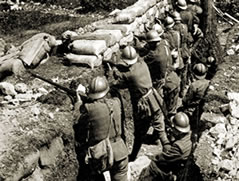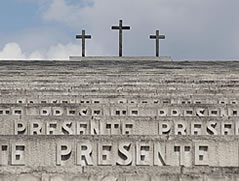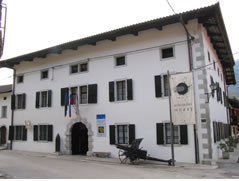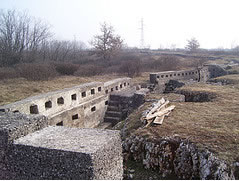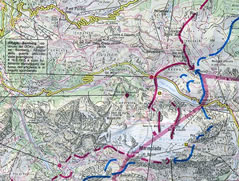
General Rommel
A landslide victoryAfter the breakthrough in Bovec and Tolmino, Twelfth Battle of the Isonzo, the battalion of German mountain of Wurttemberg in whose ranks militated an unknown lieutenant named Erwin Rommel career, was commissioned to act as a vanguard of the Jager
 Division and reach the Longarone soon as possible, to cut the road to the Cadore troops they were retreating toward the Grappa. Rommel chose the path that was the road built by the Italian Alpine between 1910 and 1912 that linked the Val Cellina to Val Meduna
Division and reach the Longarone soon as possible, to cut the road to the Cadore troops they were retreating toward the Grappa. Rommel chose the path that was the road built by the Italian Alpine between 1910 and 1912 that linked the Val Cellina to Val MedunaFork through Clautana, a path can still be traveled. Past the Soca October 24, 1917, after three days of battle and conquest of Matajur, the Wurttembergisches Gebirgs Bataillon (WGB) enters in Cividale on 27, thus covering 50 kilometers of mountain road at gunpoint in 3 days. Saturday, October 28 continues the march towards the land of Primulacco, the tower is passed on 29 without clashes. Monday, October 30, cold and rainy day, are achieved Coesano and Villanova, the 31 battalion is on the Tagliamento, where headquarters at rest until 3 November. In those days Rommel, called the German Command in Udine, he receives the order to move the cutting edge of Jager Division, reporting to the greater Sproesser, and to focus on Longarone. At dawn on November 4, the WGB passes the Tagliamento on the Cornino bridge, the direction is Meduno-Chievolis-Claut-Cimolais-Spar. A Alpini Brigade in the rear slows the path, Chievolis, November 6, the first clash: the 5th Alpini groups, Sharpshooters and gunners oppose strong resistance, only finished surrendering ammunition. That day the WGB captured four officers and 230 soldiers. The Germans then proceeded to Fork Clautana, they had joined a few batteries of mountain howitzers and a battalion of Schutzen; the advance of these troops fast, thanks to the discovery of a large number of folding bicycles bersagliere, which occurred in the plains days before, had left behind the baggage and the battle they had to prepare an empty stomach. Tuesday, November 7, the WGB is under the fork, lined up there are Italian troops. At the center of the fork are the daring of the eighteenth spearhead, left the 34 ° - 35 ° and 36 ° Alpine Company of the battalion Val Susa, right two companies of riflemen, with 6 mountain guns. Are the rearguard troops of the 26th division of Danise Colonel, with the task of holding the enemy for as long as possible. The Germans gather three companies facing up; Rommel and two sections of machine guns are positioned on the slopes of the Col Cavasso, so as to dominate defenses on the side and from above. 19 at the first assault. Italians defend themselves with order, not retreat, while suffering heavy losses from machine guns placed on the Col Cavasso. The Germans not to be better, it is impossible to approach the center, the attack is suspended. From the diary of Lieutenant Rommel:
"I give a little 'rest to my men, and in the meantime I'm going to take a look ... I can find the favorable emplacements for machine guns, just a few hundred meters from the pass ..".
Around midnight the department Rommel again attacked the fork; supported by machine guns, Jager and Schutzen arrive a few meters from the Italian line, there is a lengthy exchange of hand grenades, then back at the attackers are forced to ritirarsi.Ancora from Rommel's diary:
"..I Am annoyed. It 's the first attack since the war that goes to me bad. Hard work hours went up in smoke. A repetition of the action seems hopeless."
 Wednesday, November 8, in the pitch dark, a German patrol Salt Fork Clautana to test the Italian resistance and has a surprise: the step is empty, no trace of the defenders who have taken advantage of the night to break away and get off at Longarone. Resumes the chase, the Germans to come in at 14 Claut where a patrol of the 8th Bersaglieri, 2 officers and 30 men, try a resistance immediately won. In Claut people do find some dinner tables and WGB stops to refresh themselves.
Wednesday, November 8, in the pitch dark, a German patrol Salt Fork Clautana to test the Italian resistance and has a surprise: the step is empty, no trace of the defenders who have taken advantage of the night to break away and get off at Longarone. Resumes the chase, the Germans to come in at 14 Claut where a patrol of the 8th Bersaglieri, 2 officers and 30 men, try a resistance immediately won. In Claut people do find some dinner tables and WGB stops to refresh themselves.Meanwhile, the retreat of the Italian rearguard continues, orders and counter one another, is prepared a new line of resistance just outside Claut by two full battle battalions, withdrawn and sent to guard the pass of San Osvaldo, above Cimolais, the last before Longarone. The evening of 8 of the largest group Sproesser reaches the vanguard of Rommel in Cimolais; also comes an order from the command of Jager Division: the WGB to rest waiting for fresh troops of the 26th Schutzen. But Sproesser does not intend to give up right now, in fact asks for reinforcements. Thursday, November 9, cold and snow that cuts the face, at 5 am the troops on both sides are waiting. Opposite the step St. Oswald still Rommel and its vanguard, while a company tries to circumvent passing on high rocks of the Monte Cornetto: it's a disaster. Fresh snow betrays the attackers who slip into the cliffs and some die. No time to groped another maneuver that is not repeated in the attack Fork Clautana and so is done. The Italian defense line consists only of two companies of the 10th battalion of Sharpshooters, which is invested by blasts of machine guns on the sides and in front, while the German troops are done under. 9.45, attackers can penetrate and disorganize the defense and capture 4 officers and 120 soldiers, the others retreated to Longarone. Now jump back out bicycles bersagliere that the Germans had left the road and with these threw themselves on the descent from the pass of San Osvaldo leads to Longarone. The bridge over the gorge of Vajont is taken intact. In front of Longarone, lightly sprinkled with snow, swarming with Italian troops in retreat.
Guided tours
Thanks to the Pro Loco "Valli del Natisone - Nediske Doline" you can visit the trenches where it passed General Rommel. It starts from the Passo Solarie, in the municipality of Drenchia (from Cividale you follow the state 54 to Slovenia up to S.Quirino Bridge,
 then follow the signs to Scrutto, Clodig, St. Wolfgang).
And 'necessary to book the number 338.1260311, or by email booking@nediskedoline.it.
The itineraries on foot, on easy trails and accessible (but not equipped for the disabled) are two, either: one of about two hours and one of three hours. You can watch and take trenches and tunnels dug into the rock, ruins of forts and military structures.
Qualified guides will make "talking stones", giving Rommel's exploits on the trails by himself paths, the sufferings of the military and the pain of the victims, rivocato through the memories left by the protagonists.
then follow the signs to Scrutto, Clodig, St. Wolfgang).
And 'necessary to book the number 338.1260311, or by email booking@nediskedoline.it.
The itineraries on foot, on easy trails and accessible (but not equipped for the disabled) are two, either: one of about two hours and one of three hours. You can watch and take trenches and tunnels dug into the rock, ruins of forts and military structures.
Qualified guides will make "talking stones", giving Rommel's exploits on the trails by himself paths, the sufferings of the military and the pain of the victims, rivocato through the memories left by the protagonists.


